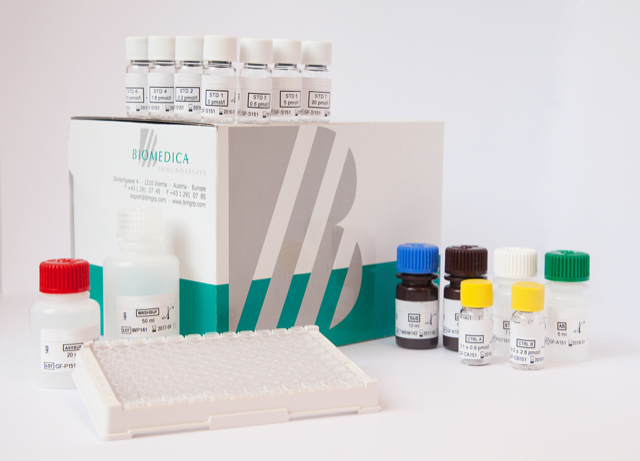Total Soluble Neuropilin-1 ELISA
Total Soluble Neuropilin-1 ELISA Developed and Manufactured in Austria by Biomedica
Size: 1×96 wells
Sensitivity: LOD: (0 pmol/l + 3 SD): 0.09 pmol/l; LLOQ: 0.09 pmol/l
Dynamic Range: 0.37 to 12 nmol/l
Incubation Time: 4 hours
Sample Type: EDTA plasma, heparin plasma, citrate plasma and cell culture
Sample Size: 10 µL
Alternative Names: NRP1, NRP-1
For Research Use Only
Controls Included
Assay Background
Neuropilin-1 (NRP1) is a single-pass transmembrane glycoprotein of 923 amino acids, composed of a large extracellular region, a short transmembrane domain and a short cytoplasmic tail. Due to alternative splicing or shedding, the extracellular region can be released into circulation as a soluble Neuropilin. NRP1 is an essential cell surface receptor functioning in many key biological processes including the cardiovascular, neuronal, and immune systems (1,2). Multiple ligands binf to the extracellular region of NPR1, like class III semaphorins which have a key role in axonal guidance, or members of the VEGF family of angiogenic cytokines. Ligand-binding to transmembrane NRP1, which has co-receptor function, leads to signaling via receptor proteins containing a PDZ domain. In contrast, ligand-binding to soluble Neuropilin-1 (sNRP1) has antagonistic properties by acting as decoy (1,3).
NRP1 is expressed by a variety of cells and tissues. For instance, the transmembrane protein is expressed by neuronal cells, endothelial cells, vascular smooth muscle cells, cardiomyocytes, multiple tumor cell lines and neoplasms, osteoblasts, naïve T cells or platelets. Expression of soluble Neuropilin-1 is further described in a variety of non-endothelial cells, e.g. in liver hepatocytes and kidney distal and proximal tubules. NRP1 is implicated in a multitude of physiological and pathological settings, e.g. in axon guidance, vascularization, tumor growth or regeneration and repair (4-9). Neuropilin-1 is described to stimulate osteoblast differentiation, to act as potential biomarker for the prediction of heart failure outcome or to play a role in renal fibrogenesis (6, 10,11). As a co-receptor for VEGF, NRP1 is a potential target for cancer therapies (12).
Related Products
Endostatin ELISA Assay Kit
BNP Fragment (Nt-proBNP 8-29) ELISA Assay Kit
Big Endothelin-1 ELISA Assay



